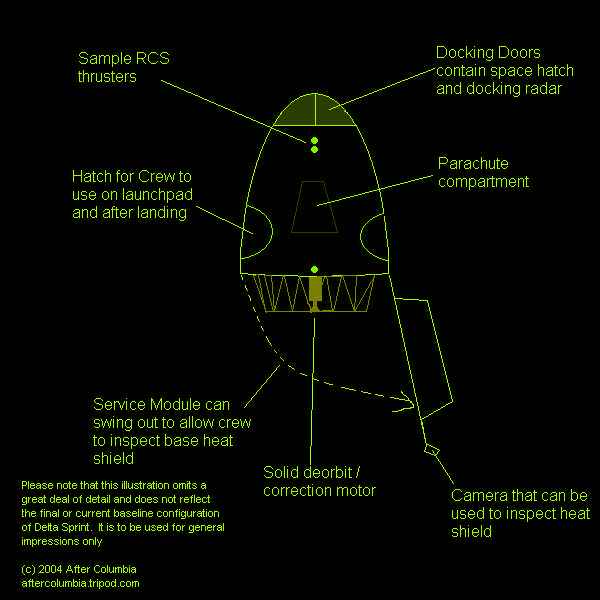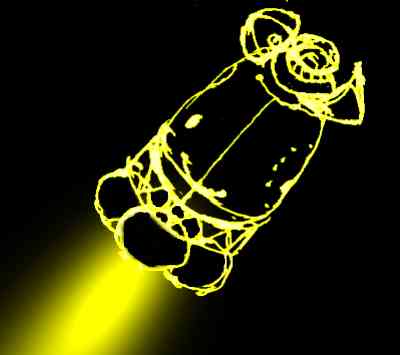1. Mission and Description
Delta Sprint is a three person crew transfer and bailout
vehicle. It is designed to get three crew members to the International Space Station and back. Later models can be
used to transfer crews to interplanetary spacecraft such as Mars Direct, and also to allow them to return from their
missions. Using the Delta II launch vehicle and Fregat upper stage, the Delta Sprint follows a
practice of being able to be developed on the faster, better, cheaper principle put forth by Daniel Goldin, and is to the
best of After Columbia's current knowledge, the first piloted spacecraft concept to do so. Use of existing hardware
and tactics ensure a simple, robust development that can be done quickly.
In the first few days and weeks after the STS-107 catastrophe, no one could
be sure that the cause of the disaster could be fixed and the Shuttle could be returned to flight. After Columbia's
first goal was to address this possibility. At first the craft was called simply "Sprint" because it would be needed
fast and on the cheap. "Sprint" was expanded into a program ( https://aftercolumbia.tripod.com/library/id2.html )
to address all the needs of the International Space Station on the fast and cheap; Delta Sprint is one of
its elements. The spacecraft, wherever possible, uses off-the-shelf subsystems, with backups and simplicity provided where
they are best suited to simplify development and enhance safety.
2. Spacecraft General Properties
Delta Sprint is a three person crew transfer vehicle. The ogive
Descent Module is best summarized as a cross between those of Gemini and Apollo and is somewhat larger than
that for Soyuz. The Service Module is a latticework truss structure
topped by an aluminum impact shield shaped like a shallow wok to fit the bottom of the Descent Module. In the center is a solid deorbit motor, flanked by three propellant tanks, bottles, batteries, and electronics. Below that, on the Standard model, is a Fregat upper stage, which looks like
six oversized bubbles arranged in a circle with little boxes, thrusters, antennae and structural fittings sticking out. The main rocket at the bottom is quite small compared to most other stages. The Service Module and Fregat are protected by a fairing that extends up to the bottom of the
Descent Module. The abort rockets are strapped on to the Descent Module either
on the top and bottom (as the crew sits) so that they do not cover the side hatches, or around the nose (haven't decided which
yet.) The Delta II rocket below the partial fairing is identical to
that which was used to launch the Mars Spirit rover in summer of 2003. The Delta
II used to Mars Opportunity used slightly larger strap-on boosters and is also being considered for a version
of Delta Sprint without the Fregat.
3. Spacecraft Ascent
Delta Sprint Standard plans to ascend on a modified Delta
II rocket with a Starsem Fregat added as a third stage. The Fregat assists in ascent and performs several
maneuvers to help rendezvous the spacecraft with the International Space Station or other docking target. The Fregat
is jettisoned before docking and deorbited into the Pacific Ocean.
4. Spacecraft Recovery
After Columbia's Summary: Our spacecraft concepts are intended to provide a 99.99% probability that you will
survive the mission. If the mission is not completed 99.99% of the time, abort systems are used to bring your odds of survival
up to 99.99%.
For complicated reasons regarding how the Descent Module flies, the crew will normally pump around water
supplies and reposition batteries prior to deorbit. As on Shuttle, they will strap on personal pressure suits and
parachutes. The entry is not as gentle as on Shuttle, the crew endure 4 to 7 gees of entry accelleration, and up
to 17 gees in rare abort situations. All of these are in the experience of piloted missions where the crew has survived (including
two Russian Soyuz aborts and the recent experience of Soyuz TMA-1, leading to two piloted entry glitches
in a row.)
After entering the atmosphere, Delta Sprint uses a parasol similar to the one used on X-38,
and will cushion the impact with the ground using airbags. The craft is not intended to bounce like a modern Mars lander,
The airbags are intended to deflate on impact similarly to the ones used in vehicles to protect the driver and passengers
from injury and death in car crashes.
Delta Sprint uses a layered approach to protect the crew from landing
system failure, primarily as a concern for damage to landing systems resulting from thermal protection system damage or poor
entry attitudes as a result of guidance failures. These combination failures are addressed in Delta Sprint because
there is little comfort to astonauts saved by backup tiles if all they have to look forward to is dying in a crash.
Delta Sprint uses existing Shuttle materials in its thermal
protections system. Facilities will be provided for on-mission inspection and repair, and impact damage resistant to up to
a 2.54cm hole anywhere in the base shield assuming layered backup materials have not been compromised. During ascent an on
orbit, the base shield is protected by the Service Module and an impact shield that is a part of it. Delta Sprint,
unlike Shuttle, can allow crew survival in the event of a complete guidance system failure (but not a complete electrical
system failure, as electricity is still required to fire thrusters and ordinance.)
5. Spacecraft Mission Technologies
As emphasized elsewhere in this report, Delta Sprint uses existing off-the-shelf systems wherever possible to
complete its mission. The Descent Module will be constructed of an aluminum-copper alloy and will contain the most reliable
systems currently available. The Service Module contains the most hazardous systems, including the solid fueled deorbit motor
and orbital maneuvering engines. The Service Module has the ability to swing out to allow spacewalk or remote inspection of
the thermal protection designed to protect you during the fiery return to Earth. The prospect of total guidance failure is
only barely survivable and would no doubt be terrifying. To prevent this, the guidance system uses three computers, two of
which need to fail before there is a major problem.
The Sprint Program is built on the premise that the Shuttle
is unsafe to fly with a crew on board as a result of either technical, organizational, cost related, or spiritual ("cultural"
by the CAIB) problems.After Columbia is expecting opposition from Shuttle advocates and advanced technology
research groups. We also believe that a craft like Delta Sprint is absolutely required to continue piloted space
travel for the immediate future
The intent of Delta Sprint is to use existing, off the shelf components and technologies
wherever possible, including and existing, proven reliable launch vehicle. Not
all systems used for Delta Sprint need to be flight proven in space in order for this to take place. Existing avionics hardware should be adaptable. Life Support
components may be available from mine collapse survival shelters. The recovery
mode has been proven in flight by X-38 to be feasible in a vehicle larger than Delta Sprint.
Serious arguments against Delta Sprint will not be based on what it does but
by what it does not do and will probably be most loudly voiced by those who ask for too much in one ship.
Update 4 Oct 2004: Delta Sprint may need to be developed commercially, as NASA and
Boeing have consistently ignored After Columbia's attempts to establish contact. The potential commercial market for
Delta Sprint depends on costs and is most strongly influences by ascent method
Delta Sprint II 6 place LEO and Delta Sprint II 4 place Planetary configurations have
applications and response in private and amateur space communities. The 6 place LEO configuration in particular meets
the criteria for the America's Space Prize anticipated from Bigelow Aerospace, while the 4 place Planetary model may be used
for PERMANENT and Mars Exploration missions.
|
 |
|
|
|
 |
|

| Rendezvous maneuver using Fregat |

|
| An old drawing with a new glow |
Quik Links:
Addendum 1 uploaded 1 June 2004:
Section 4.2.2 Alternate Recovery Hardware
Section 5.1.8 Communications
This report has not been fixed for quotation marks and apostrophes removed from uploads by Trellix Site Builder.
|
 |
|
|
|
|


